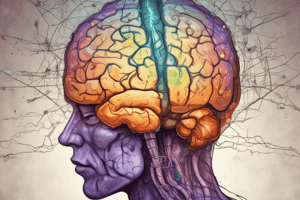Podcast
Questions and Answers
Which age groups tend to have the highest rates of Traumatic Brain Injury (TBI)?
Which age groups tend to have the highest rates of Traumatic Brain Injury (TBI)?
- 30-40 years and 50-60 years
- 25-35 years and 60-70 years
- 0-4 years and 15-24 years (correct)
- 12-18 years and 40-50 years
What are the leading causes of Traumatic Brain Injury (TBI) as mentioned in the text?
What are the leading causes of Traumatic Brain Injury (TBI) as mentioned in the text?
- Drowning and burns
- Poisoning and lightning strikes
- Sports injuries and suffocation
- Falls and motor vehicle accidents (correct)
How can Traumatic Brain Injury (TBI) be classified according to the text?
How can Traumatic Brain Injury (TBI) be classified according to the text?
- Mild head injury and moderate head injury
- Closed head injury and penetrating head injury (correct)
- Internal head injury and external head injury
- Simple head injury and severe head injury
What type of patient presentation is described in the text for Traumatic Brain Injury (TBI)?
What type of patient presentation is described in the text for Traumatic Brain Injury (TBI)?
What does the pathogenesis of Traumatic Brain Injury (TBI) result from?
What does the pathogenesis of Traumatic Brain Injury (TBI) result from?
What is the primary cause of traumatic brain injury (TBI)?
What is the primary cause of traumatic brain injury (TBI)?
Which doctrine states that the total intracranial volume is fixed because of the inelastic nature of the skull?
Which doctrine states that the total intracranial volume is fixed because of the inelastic nature of the skull?
What concept refers to the change in pressure due to changes in volume within the intracranial compartment?
What concept refers to the change in pressure due to changes in volume within the intracranial compartment?
In TBI, what can develop due to significant head injuries and increases the relative volume of the brain?
In TBI, what can develop due to significant head injuries and increases the relative volume of the brain?
Which type of injury can result from external trauma to the head and cause TBI?
Which type of injury can result from external trauma to the head and cause TBI?
How many TBI-related emergency department visits, hospitalizations, and deaths were reported in the United States in 2014?
How many TBI-related emergency department visits, hospitalizations, and deaths were reported in the United States in 2014?
Flashcards are hidden until you start studying
Study Notes
Traumatic Brain Injury: An Overview
Traumatic brain injury (TBI) is a significant public health issue, with millions of cases reported annually worldwide. TBI can range from mild alterations in consciousness to severe injuries that affect the entire brain and can lead to death. The primary cause of TBI is external trauma to the head, which can result in various types of injuries, including concussions, skull fractures, and hematomas.
Pathophysiology
The brain is encased within the skull, a rigid and inelastic container. Due to this, only small increases in volume within the intracranial compartment are tolerated before pressure within the compartment rises. This concept is known as the Monro-Kellie doctrine, which states that the total intracranial volume is fixed because of the inelastic nature of the skull.
When a significant head injury occurs, cerebral edema often develops, which increases the relative volume of the brain. Since the intracranial volume is fixed, the pressure within this compartment rises unless some compensatory action occurs. This is related to the concept of intracranial compliance, which is the change in pressure due to changes in volume.
Epidemiology
TBI is a significant public health issue, with approximately 2.87 million TBI-related emergency department (ED) visits, hospitalizations, and deaths reported in the United States in 2014. The highest rates of TBI tend to be in young age groups (0-4 years and 15-24 years), with the leading causes being falls and motor vehicle accidents.
Types of TBI
TBI can be classified into two broad categories: closed head injury and penetrating head injury. The clinical presentation of patients with TBI varies significantly, from an ambulatory patient complaining of a sports-related head injury to a moribund patient arriving via helicopter. The pathogenesis of TBI is a complex process that results from primary and secondary injuries, leading to temporary or permanent damage to the brain.
Conclusion
Traumatic brain injury is a serious and common condition that can result in significant physical, cognitive, and emotional impairments. Understanding the pathophysiology, epidemiology, and various types of TBI is crucial for healthcare providers to provide appropriate management and care for affected individuals.
Studying That Suits You
Use AI to generate personalized quizzes and flashcards to suit your learning preferences.




